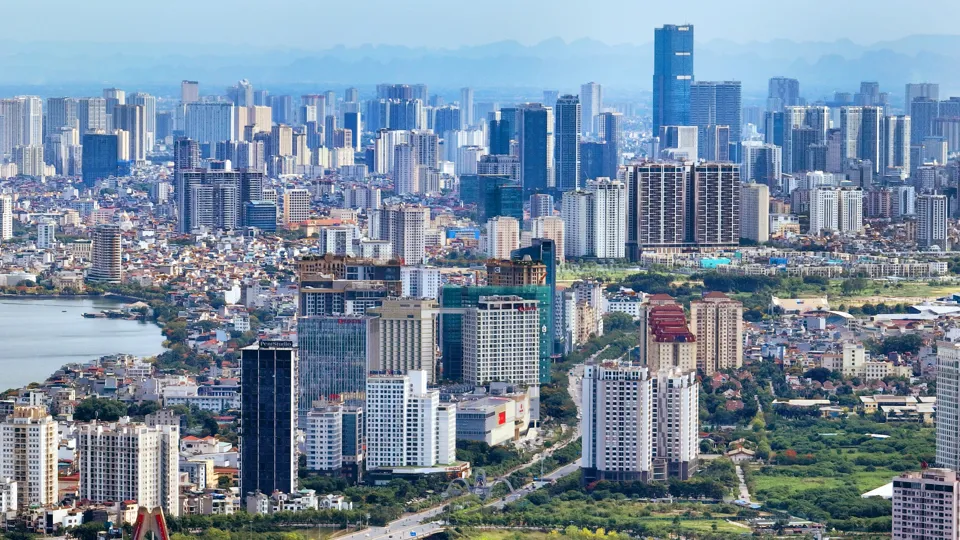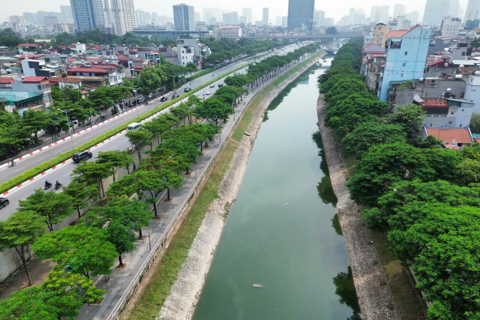Government assigns cities/provinces minimum growth rate of 8% this year
Hanoi and Ho Chi Minh City—the country’s two economic hubs—have been tasked with growth targets of 8% and 8.5%, respectively.
Local governments are required to achieve a Gross Regional Domestic Product (GRDP) growth of at least 8%, with two-thirds of them expected to attain double-digit growth, according to the Government’s resolution No.25.
| Hanoi from above. Photo: Pham Hung/The Hanoi Times |
The Vietnamese Government has set a minimum GDP growth target of 8% for this year, with the aim of building momentum for double-digit economic expansion in subsequent years.
Approximately two-thirds of them are expected to attain double-digit growth, including Bac Giang (13.6%), Thanh Hoa (11%), Danang (10%), and Quang Ninh (12%).
Hanoi and Ho Chi Minh City—the country’s two economic hubs—have been assigned growth targets of 8% and 8.5%, respectively. These figures represent increases of 1.46 and 1.33 percentage points over last year’s GRDP.
Among the five largest subnational economies, three are expected to exceed 10% growth: Haiphong (12.5%), Dong Nai (10%), and Binh Duong (10.2%).
The government has also introduced additional sectoral and industrial targets, assigning specific responsibilities to ministries. The Ministry of Finance must reduce recurrent expenditure to 60% of total state budget spending while increasing development investment to 31%. The Ministry of Planning and Investment is tasked with ensuring that total implemented investment accounts for 33.5% of GDP.
Meanwhile, the Ministry of Industry and Trade is responsible for key trade and production indicators, including a 12% increase in total export turnover, a $30 billion trade surplus, a 9.5% rise in the industrial production index, and a 12% increase in total retail sales and service revenues.
The government has also set an ambitious tourism target for 2024, aiming to attract 22–23 million international visitors and 120–130 million domestic travelers. The Ministry of Culture, Sports, and Tourism will oversee efforts to boost domestic consumption, a key driver of economic growth.
“All ministries, sectors, and localities must develop monthly and quarterly growth scenarios and ensure their implementation to meet the targets,” the resolution states.
Achieving an 8% GDP growth rate this year is considered to be highly challenging, requiring significant institutional and policy reforms. However, reaching high growth rates is seen as a critical step toward Vietnam’s goal of becoming a high-income nation by 2045.
Public investment remains a key driver for achieving these ambitious growth targets. In January alone, public investment disbursement reached VND35.4 trillion (US$1.4 billion), a 9.6% increase from the same period last year.
Minister of Planning and Investment Nguyen Chi Dung noted that 2025 presents favorable conditions for accelerating public investment disbursement. Major projects, including Long Thanh International Airport, Ring Road 3 in Ho Chi Minh City, and Ring Road 4 in Hanoi, are entering their final stages. These projects are expected to unlock new growth potential in their respective regions.
Additionally, institutional reforms remain a top priority, with the government identifying them as a "breakthrough of breakthroughs."
Dung emphasized that long-standing bottlenecks, particularly those affecting investment projects, will be systematically addressed.











